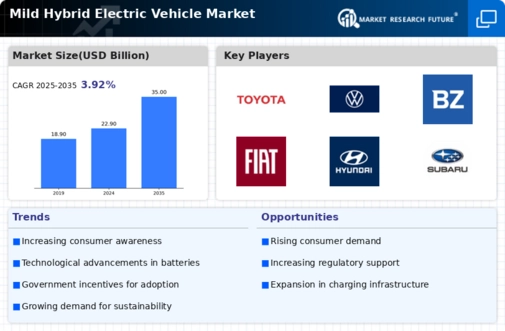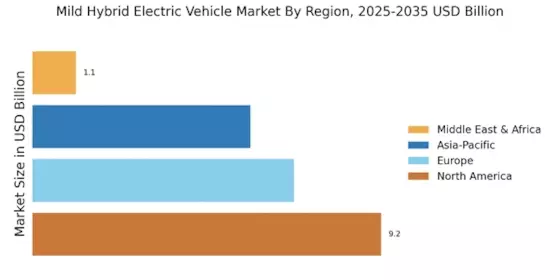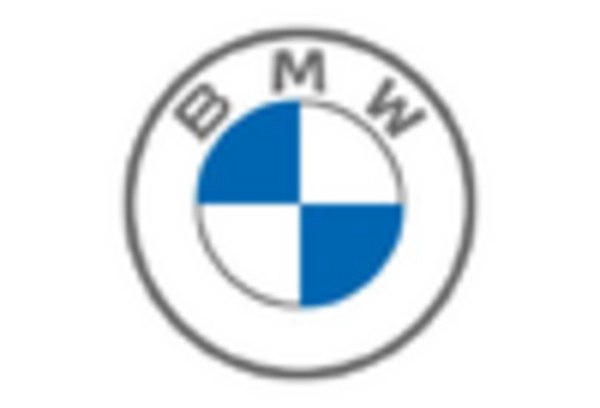Consumer Demand for Sustainable Mobility
The Mild Hybrid Electric Vehicle Market is witnessing a notable shift in consumer demand towards sustainable mobility solutions. As awareness of environmental issues grows, consumers are increasingly seeking vehicles that offer lower emissions and better fuel efficiency. Mild hybrid vehicles, which combine traditional internal combustion engines with electric propulsion, provide a compelling option for eco-conscious buyers. Recent surveys indicate that nearly 60% of consumers are willing to pay a premium for vehicles that are environmentally friendly. This shift in consumer preferences is prompting manufacturers to expand their mild hybrid offerings, thereby enhancing competition within the Mild Hybrid Electric Vehicle Market. The increasing availability of models and features tailored to sustainability is likely to further stimulate market growth in the coming years.
Economic Incentives and Government Subsidies
The Mild Hybrid Electric Vehicle Market is benefiting from various economic incentives and government subsidies aimed at promoting the adoption of cleaner vehicles. Many governments are offering tax credits, rebates, and other financial incentives to encourage consumers to purchase mild hybrid vehicles. These incentives can significantly reduce the overall cost of ownership, making mild hybrids more attractive to a broader audience. For example, data shows that regions with substantial government support have experienced a 25% increase in mild hybrid vehicle registrations. This financial backing not only aids consumers but also encourages manufacturers to invest in the development of new models. As these incentives continue to evolve, they are likely to play a pivotal role in shaping the future landscape of the Mild Hybrid Electric Vehicle Market.
Regulatory Compliance and Emission Standards
The Mild Hybrid Electric Vehicle Market is significantly influenced by stringent regulatory compliance and evolving emission standards. Governments worldwide are implementing more rigorous regulations aimed at reducing greenhouse gas emissions and promoting cleaner transportation solutions. For instance, many regions have set ambitious targets for reducing carbon emissions by 2030, which has led to increased demand for mild hybrid vehicles that meet these standards. The market is projected to grow as manufacturers adapt their offerings to comply with these regulations. In fact, data indicates that regions with strict emission norms have seen a rise in mild hybrid vehicle sales by over 30% in recent years. This trend suggests that regulatory frameworks are not only shaping consumer preferences but also driving innovation within the Mild Hybrid Electric Vehicle Market.
Technological Advancements in Battery Systems
The Mild Hybrid Electric Vehicle Market is experiencing a surge in technological advancements, particularly in battery systems. Innovations such as lithium-ion and solid-state batteries are enhancing energy efficiency and performance. These advancements are crucial as they allow mild hybrids to offer improved fuel economy and reduced emissions. According to recent data, the efficiency of mild hybrid systems has increased by approximately 20% over the past few years, making them more appealing to consumers. Furthermore, the integration of regenerative braking systems is becoming more prevalent, allowing vehicles to recover energy during braking. This not only enhances the driving experience but also contributes to the overall sustainability of the Mild Hybrid Electric Vehicle Market. As manufacturers continue to invest in research and development, the potential for further improvements in battery technology remains high.
Infrastructure Development for Electric Vehicles
The Mild Hybrid Electric Vehicle Market is closely linked to the ongoing development of infrastructure for electric vehicles. As charging stations and support facilities become more widespread, the practicality of owning a mild hybrid vehicle increases. This infrastructure development is essential for alleviating consumer concerns regarding range anxiety and charging accessibility. Recent reports indicate that investments in charging infrastructure have surged, with a projected growth rate of 15% annually. This expansion not only supports the existing mild hybrid market but also encourages potential buyers to consider these vehicles as viable alternatives to traditional gasoline-powered cars. The synergy between infrastructure development and the Mild Hybrid Electric Vehicle Market is likely to foster a more robust ecosystem for sustainable transportation solutions.


















Leave a Comment